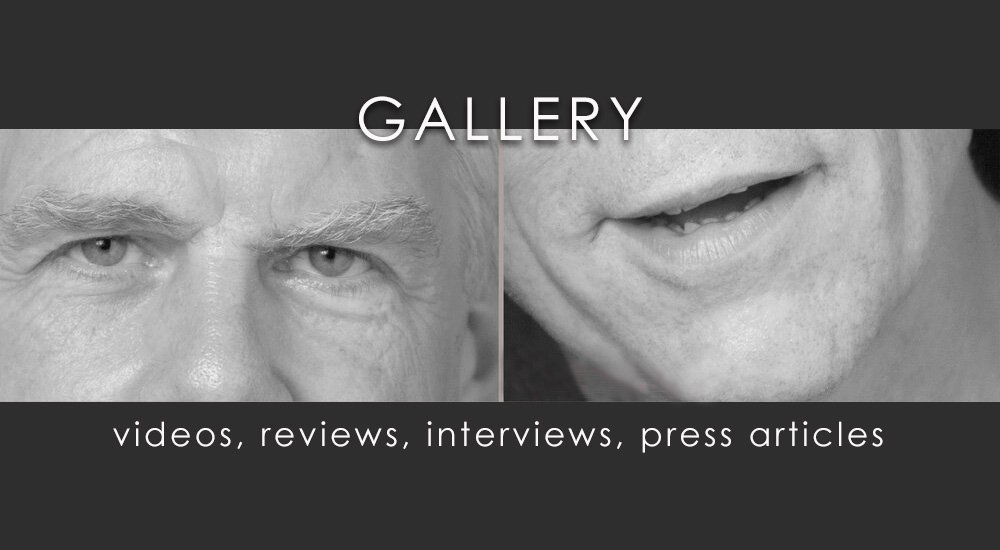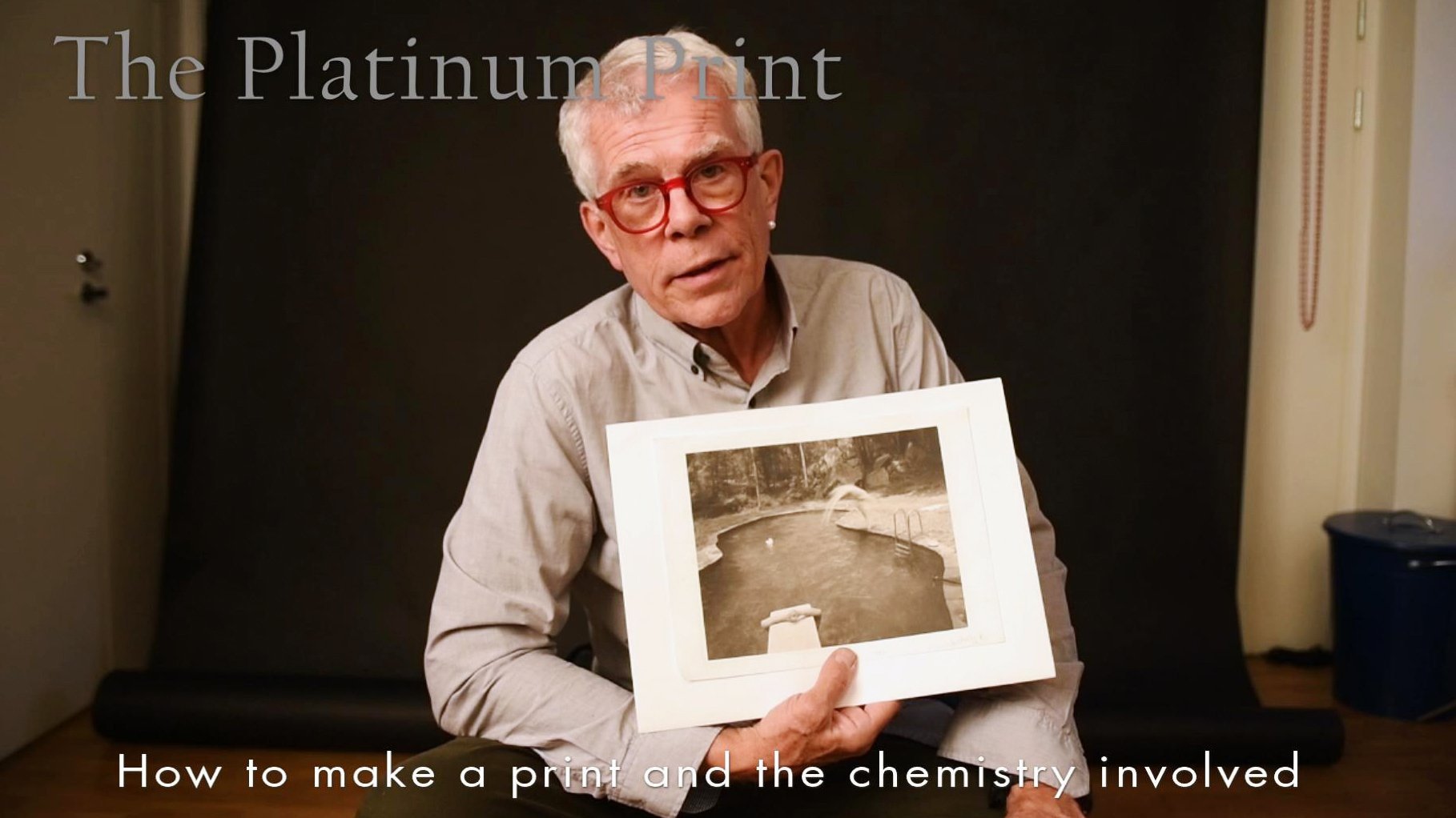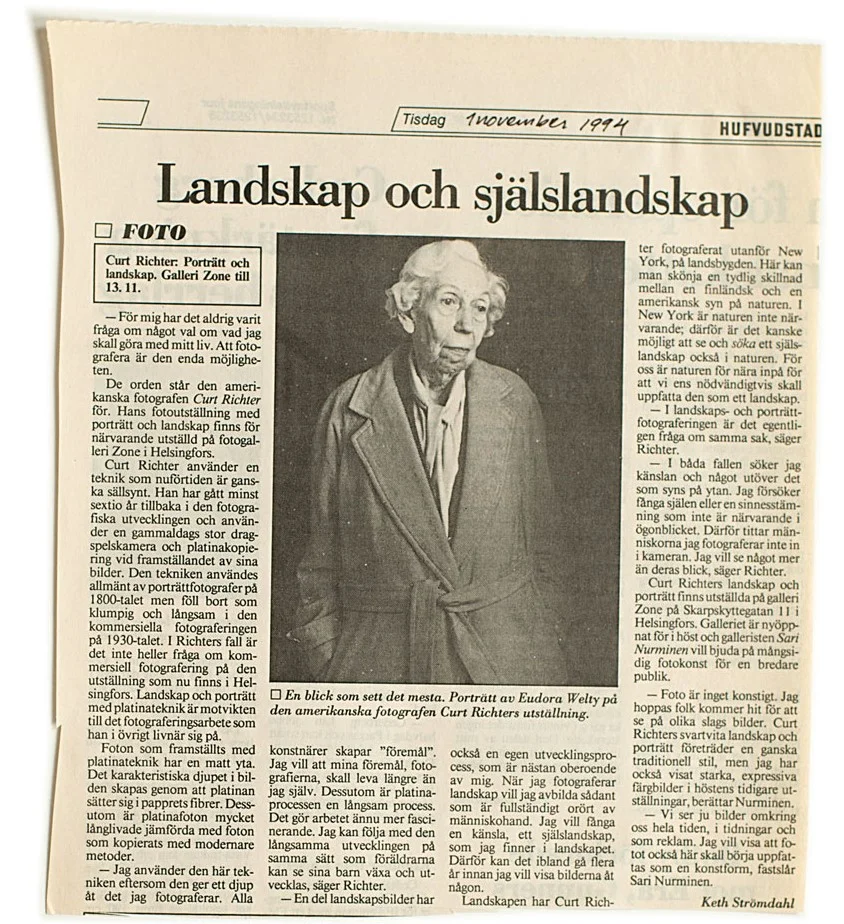Narratives / About / Lab Notes
Video Narratives, Photographic and Printing Ideas & Solutions and Interviews with Curt Richter























Platinum printing is one of the oldest photographic processes and it remains unsurpassed in its delicate tonal range and subtle surface texture.
Platinum prints are as elegant as they are permanent. The process has an extended tonal range and deeper blacks compared to other photographic prints. One of the most distinctive qualities of a platinum print is that the image is in the paper, not on its surface, much like the ink in a lithograph or an etching. This is due to the emulsion being absorbed and becoming involved with the paper’s fibers. Throughout the 19th Century platinum was pursued and refined for use in photography. The most persistent impediment was removing the unexposed platinum salts after the image was developed. In 1873 chemical improvements made it possible to commercially manufacture platinum paper. It gained considerable market share and was favored by artists for its delicate qualities. Its commercial success peaked in the beginning of the 20th century but the onset of W.W.I. saw the beginning of its eventual demise. At that time, Russia mined 90% of the world supply and availability was scarce. When production resumed after the war it was discovered that palladium (one of six metals in the platinum family) could be added or substituted completely for platinum. But the metal’s expense and shifting aesthetic trends brought commercial production to an end in 1930. In his “Day Books”, Edward Weston noted printing on his last sheets of platino paper. Today his platinum prints are among his most valued images. But some photographers would not give up the paper’s insurmountable attributes. A small number continued to make prints as the technique is relatively simple, requiring only three compounds to coat the paper and two to process a print once exposed. Like the 17 year locust, platinum prints seemed to disappear until photography’s Neoclassic movement in the 1970s. Artists such as Jan Groover, who contributed to the transformation of color photography as an accepted and collectible medium, also made platinum/palladium prints.
The advent of digital photography in the late 1990s rendered chemical photography obsolete. As of this writing, commercial film is all but gone from common usage. The number of platinum printers has also dwindled dramatically. The tonal range of a high-quality digital print can resemble a platinum/palladium print. None of the digital prints compares to the surface quality and subtlety of a platinum print or the archival durability.
#platinumprint #platinumprinting #platinum #palladium #platinupalladiumprinting #blackandwhitephotography #ferricoxalate #platinumsensitizer #19thcenturyphotogrphotography #alternativeprintingprocess #altprocess #darkroom #filmphotography #art #photograhy #artphotography #thekeepersofthelight #williamwillis #frederickevans #phemerson #juliamargaretcameron #alvinlangdoncoburn #alfredstieglitz #edwardsteichen #paulstrand #imogencunningham #edwardweston #tinamodotti #anseladams #willardvandyke #manuelalvarezbravo #geogetice #williamcrawford #irvingpenn #jangroover #davidbailey #robertmapplethorpe #groupf64 #photosecession #cameraworks #sunypurchase #fredfoster
THE PRINT SCROLL
A platinum print becomes vulnerable to tearing or damage when it's wet during processing or washing. The Print Scroll makes handling the paper easy by supporting it from the developer to the drying rack.
Look for more videos by - Curt RichterPhotography/YouTube
This video is a brief explanation of how a radiometer functions. Although light doesn't have mass there is substance in the protons it carries. Light's energy can have an impact on tangible objects. See for yourself.
The Queen’s Piper
Where were you when the Queen was laid to rest?
Sept.19, 2022 at 5:00PM GMT
Listening to / the radio / driving home from work / when the piper / sounded his final lament
"A Fendersmith is a person employed to clean and repair the metal fenders before fireplaces in mansions, fine estates, or castles. In this archaic profession, the same person is usually also responsible for lighting and keeping the fire contained within the fireplace. Few fendersmiths exist today, but can be found in places like Windsor Castle."
#TheQueen #Queen #QueenElizabeth #QueenElizabethII #royalfamily #TheQueensPiper #TheQueensFuneral #WestminsterAbbey #london #uk #bbcradio #Sept192022 #TheSaluteoftheRoyalFendersmith
#listeningto #theradio #drivinghomefromwork #whenthepiper #soundedhislament
#videoart #platinumprint #platinumprinting #platinum #palladium #platinupalladiumprinting #blackandwhitephotography #ferricoxalate #platinumsensitizer #19thcenturyphotogrphotography #alternativeprintingprocess #altprocess #darkroom #filmphotography #art #photography #artphotography
Towards the end of the First World War Arthur Mole began constructing, what he called “living photographs”. These were optical illusions, a magic trick with a camera.
Fred’s Ferric Oxalate, a sensitizer for platinum & palladium printing, is now available for sale to platinum and kallitype printers. 100ml bottle costs €30 or US $37 plus shipping, tax where applicable. To order, contact me at cpr@curtrichter.com.
Platinum prints should be constantly agitated to ensure all the iron and salts have been removed. This wipe shield wiper motor does the job.
Interview in Key West, 2008
Interview in Helsinki, May 2009.
Interview in November 2013
Interview in SixDegrees 5/2009
Photographer Curt Richter is a seasoned veteran behind the lens. The Helsinki-based American has an abundant body of work from his long and checkered career as a freelance photographer. But how does he fit into the Finnish visual arts community?
Interview in Oxford American 1/1997
Article in Hufvudstadsbladet, February 1998
Article in Suomen Kuvalehti, May 2009.
Review in Hufvudstadsbladet 01.11.1994
Video Narratives, Photographic and Printing Ideas & Solutions and Interviews with Curt Richter